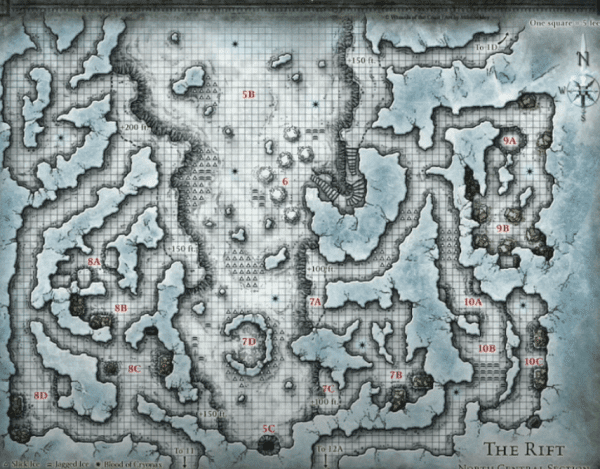I love looking at underappreciated monsters you just don’t see very often. One of these is, without a doubt, the ice elemental 5e. While other elementals feature in campaigns much more often – looking at you fire elemental – by both the DM and players, these monsters bring some unique skills.
In this guide, I will discuss their stats, special abilities, and resistances. After that, I will give tips to fellow DMs on how to use these creatures in your campaign. Don’t worry, and I will also give players a ton of nifty tips on defeating an ice elemental in 5e DnD.

What is an Ice Elemental 5e DnD?
An ice elemental creature is composed of ice and snow, typically found in cold environments. They are related to the element of water but are also closely associated with coldness. Ice Elementals are tall humanoid creatures with an appearance reminiscent of frozen water with a semi-transparent blue-white coloration.
When encountered outside the place they usually live, they have an icy blue skin tone, but when ice elementals enter their native environment, they can change their skin color to match the surrounding snow with a bluish hue. Ice Elementals appear as giant humanoid beings composed entirely of ice and snow. They seem to grow even taller when the temperature gets colder.
Ice elementals are water-loving creatures and often dwell in colder regions such as glaciers, arctic areas, or remote mountaintops. They are made of ice and are immune to cold damage, and take half damage from non-magical fire damage.
- Ice elementals are composed of ice and snow, found in cold environments.
- They are related to water and associated with coldness.
- Ice elementals have a tall humanoid form, appearing semi-transparent and blue-white.
- In their native environment, their skin color changes to match the surrounding snow with a bluish hue.
- Ice elementals grow taller in colder temperatures.
- They dwell in glaciers, arctic areas, or remote mountaintops.
- Being made of ice, they are immune to cold damage.
- They take half damage from non-magical fire damage.

Ice elemental 5e Stats
| Aspect | Stat | Description |
|---|---|---|
| Speed | Walking | 30 feet per movement action |
| Burrowing | 30 feet in snow; not in rocks or solid frozen ground | |
| Climbing | Capable of climbing in mountainous terrain | |
| Hit Points | 114 (12d10 + 48) | High hit points, suitable as a tank or formidable opponent |
| Armor Class | 15 | Decent armor class, offering opportunities for damage |
| Strength | 18 (+4) | Impressive strength, poses a threat in close range combat |
| Dexterity | 9 (-1) | Low dexterity, making them vulnerable to certain attacks |
| Constitution | 19 (+4) | Strong constitution, contributing to their survivability |
| Intelligence | 5 (-3) | Very low intelligence, making them susceptible to outsmarting |
| Wisdom | 14 (+2) | Surprisingly high wisdom, useful for certain saving throws |
| Charisma | 6 (-2) | Low charisma, but not a significant drawback |
| Saving Throws | Strength (+7) | Strong saving throw in strength, advantageous for certain situations |
Speed
Their speed is exciting. They have three kinds of movements. First is their walking speed; this is 30 feet per movement action. Nothing too special. However, they can also burrow at the same speed of 30 feet!
This speed means you can use them in an underground ambush. However, they can only burrow at this speed in the snow. So not in rocks or solid frozen ground.
The thing I find most interesting about this monster is that they can climb! So naturally, the creatures aren’t going to climb into trees but in the mountains, which is their natural environment.
Hit Points
If you are an adventuring group and need a tank to take some hits, these monsters would be your perfect ally. However, if you are fighting them, make sure you are prepared for a long fight. Their hit points of 114 (12d10 + 48) are pretty high, so they will be able to put up quite a fight!
Armor Class
With an armor class of 15, you will have plenty of opportunities to deal some good damage. Unfortunately, while they might be made out of rock-solid materials and ice elementals, their natural armor isn’t too impressive.
Strength
Their greatest strength is, well, their strength. Ice Elementals have an STR of 18 (+4), which is quite a scary stat for beginning adventurers who come into close range. They will hit high, and they will often hit, so make sure you are high enough level to take them on.
Dexterity
Being a block of solid ice doesn’t do you any favors in the dexterity department. With only a 9 (-1), this is an alarming stat for them. However, some monsters are quite a bit weaker in this regard. Dexterity is also by far not their most worthless stat.
Constitution
While these creatures’ dexterity might not be very high, their constitution makes up quite a lot. They have a 19 (+4) in this stat, so they should not be underestimated in this regard. While it is not the most valuable stat to have as a monster that is getting tag teamed by crazy adventurers, it does help their survivability.
Intelligence
Ice, as it turns out, isn’t brilliant. This hulking block of frozen water has a ridiculously low INT stat. It has just 5 (-3). This means that your players are almost going to be able to outsmart the ice elementals. However, you can have some kind of frost wizard give them orders to somewhat make up for this.
If you are a player, this will be your main advantage against them. However, almost every character built, including the Homebrew race, has higher intelligence than this. So from a pure stat perspective, trying to outsmart them is almost always going to work.
Wisdom
Surprisingly, the Ice Elemental 5e has quite a high stat in Wisdom. They have a 14 (+2) in this aspect, so that is not bad! As a dungeon master, however, there is not much you can do with this stat that will help you give your players a challenge. You might make some saving throws, however!
Charisma
In 5e, Ice elementals have a pretty low charisma. However, they only have 6 (-2) in the stat, so this will not give you any problems as a player. As a dungeon master, Charisma is not all that useful anyway, so I do not see this as a significant drawback against them.
Saving throws
These creatures have one major saving throw at their disposal: the +7 They have in strength. So any time you want them to do a strength check will give them a pretty significant advantage.
Of course, for your players, this would be a nightmare to deal with. However, as a DM, you can probably foil quite many schemes from the adventurers if you play your cards right!

Immunities and vulnerabilities
Damage Vulnerabilities
No surprise here, Ice Elementals are weak to fire in Dungeons and Dragons. So that means an attack based on the fire element will do double damage. This damage modifier is a pretty prominent disadvantage for you as a DM since almost every party has a wizard or magic caster able to fire off something based on fire.
Damage Resistances
Being made out of solid ice is bound to give you quite some resistance. The beasts are immune to bludgeoning, piercing, and slashing from non-magical attacks.
Side note: In my Homebrew, I do not make them resistant to bludgeoning attacks; if you have ever tried to break a chunk of ice, you do so with, for example, a large hammer. So I make them just as effective as a regular attack in my campaigns.
Damage immunities
Ice elementals 5e have two immunities. The first one is – of course – cold. The other is poison damage. Many ‘non-living’ summoned creatures like helmed horrors are immune to poison damage, so keep this in mind as a player. The cold damage is pronounced; what I do in my homebrew campaigns is the following:
If someone casts water or ice-based spell, the elemental heals its wounds and regains hit points. This regeneration is, of course, my take on the thing, so you don’t have to do this, but I think it is pretty funny to do as a DM.
Condition Immunities
These creatures have a pretty extensive range of immunities. That goes for other elementals too. They are immune to exhaustion, petrification, getting paralyzed, getting poisoned by, for example, Cloudkill 5e, and falling unconscious. So that is quite a list. As a DM, I would advise you not to make this list longer. This is already quite enough, in my opinion.
Actions
I love the actions these monsters have! They have a unique one in Encase in Ice, and their Ice claw should not be underestimated!
Ice Claw: This is classified as a melee weapon attack. It has +7 to hit and has a reach of 5 feet. It strikes one target for 13 slashing damage. So if you are a level one adventurer, stay away because you will not survive this attack if it is a multi-attack. The multi-attack is two ice claw attacks.
Encase in ice: This is an extraordinary special attack to surprise your players. It is a melee weapon attack that has a 10 feet range. It hits one creature with 14 cold damage. However, that is not all. The target needs to make a DC 14 Constitution saving throw.
If the player fails to do so, he needs to do another one when it’s their turn again. They remain petrified until a saving throw is made or until the player (or target) has spent an hour in a warm environment. Alternatively, for example, you can cast create bonfire under the target to deal fire damage to it and thaw them out immediately.
Other
Challenge: These monsters have a Challenge Rating (CR) of 5. When you kill an Ice Elemental 5e, they will give you a total of 1800 XP. This experience amount is divided by the number of party members. If you have summoned The ultimate Planar Ally 5e DnD Guide a creature like a Planar Ally to help you in battle, this creature will also share in the exp, so keep this in mind!
Senses: They have a dark vision of 60 feet and a passive perception of 12. So they are pretty good to use at night to ambush your players who are treating through a snowy landscape and aren’t doing their perception checks.
Language: Being connected to the elemental plane of water, these creatures speak Aquan. One of the four primordial dialects. This primordial dialect is a language that Aquatic Elves and Merfolk also talk about. Since they talk to Aquan, they also understand the other three primordial dialects.
Ice elemental 5e Special treats
- Ice Glide: When the creature does this, it burrows through the ice without any magical properties. It does not disturb the ice it goes through when it does so.
- Ice Walk: Thanks to this particular skill, the monster can just move and climb across ice surfaces without needing an ability check. As a bonus, if the complex terrain is covered in ice, it does not ‘pay’ extra movement.
- Splinter: When a player or a creature hits the ice elemental with a melee weapon that deals bludgeoning damage. The elemental will splinter and deal 1d6 or three ice damage to anyone around him in a range of 5 feet.
Stat block summary
| STR | DEX | CON | INT | WIS | CHA |
| 18 (+4) | 9 (-1) | 19 (+4) | 5 (-3) | 14 (+2) | 6 (-2) |
| Armor Class | Hit Points | Speed |
| 15 | 114 (12d10+48) | 30ft., climb 20ft., burrow 30 ft. |
As you can see, these monsters aren’t pushovers. If you are a beginning adventurer, it will be hard for you and your party to take one down. Let alone if you are fighting a group of them.
I strongly advise you to make sure you have a backup plan if you are a low-level group. That backup plan should have to do something with fire, a lot of it.

Using an Ice elemental as a Dungeon Master in 5e
- use them as traps
- Neutral alignment monsters
- Practically immortal if not killed
- Loyal to master after death
Neutral alignment
These monsters are neutral alignment-wise. So as a dungeon master, I would strongly recommend you not to have them blindly attack your party. Instead, you should have something that sets them off. This trigger could be something small and subtle that doesn’t scream trap too much but is still something they should be careful about.
Example story
What I did in a previous campaign was the following: I have a crude ice sculpture with an amulet on it and some tiny ruins nearby. The charm was not magical but would fetch a pretty penny since it had a lovely sapphire made out of gold.
The amulet belonged to a frost wizard who had perished out of old age. When the players would take the charm, one or two ice elementals would attack them since their last order was to protect the wizard and his belongings when he felt his life force leaving his body.
This is just one example of a possible ‘trigger’ for this event, but it is an excellent basis to start from.
Fighting them as a Player
The best thing you can do is do perception checks to find out if there is nothing funky going on or if your DM has not set a trap for you. However, they aren’t vital if you are level 8 or more. So going to battle with them as a player is pretty straightforward. If you have something that does fire damage, this will help you a great deal in taking them down due to them taking double damage from this.
There are only three things that make this monster so dangerous, in my opinion:
- Their ability to burrow and ambush you or escape.
- Their large hit points pool. This makes it hard for a party of low levels to take them down.
- An ice elemental has quite a high strength stat.
They also have a +7 in regards to saving throws for this stat. So it would be wise not to underestimate that if your AC is not very high.
Ice Elemental FAQ
Question: What are some weaknesses of ice elementals?
Answer: Ice elementals are vulnerable to fire and take double damage from it. They can also be killed by any attack that deals enough damage. Once they are reduced to 0 hit points, they turn into a liquid form of ice that will quickly melt away in natural sunlight or warm temperature.
Where do Ice Elementals live?
Answer: The ice elemental can be found in cold environments, such as the mountains or the tundra. Places, where it is always winter, are where they feel most at home.
They are one of the non-humanoid races, and they get along with other humanoids, but they prefer to be around their race. On the other hand, they are not ambitious either, so they seldom roam far from where they were born or created.
Question: What are lesser and minor ice elementals?
Answer: These are a Homebrew version of the standard version of this monster. They are a bit weaker and smaller. I make them only 80% as mighty for my campaigns and give them a challenge rating of 3. I keep their abilities the same to make sure they are not too weak for my players. They are great to throw at a party that is around level 4 or 5.
Question: How big is this monster in 5e dnd?
Answer: Ice elementals in 5e are large creatures that stand at about 10 to 12 feet tall. According to the Dungeons and Dragons rule book, this size means they classify as giant monsters. Therefore, they won’t be able to follow you if you, for example, try to escape through a narrow path of one square (5ft.). This one square space is pretty helpful info to remember during combat, too, since there will be more squares around the monster, and it has a special splinter attack that hits everything within 5 feet if you do bludgeoning damage to it.
My final thoughts about the Ice Elemental
If you are playing 5e DnD, ice elementals are a great monster to spice things up and have a unique monster encounter. Both players and DMs will have a ton of fun with this creature, so I strongly advise you to try it.
My final tips for you would be to 1. Adjust the monster a bit so bludgeoning it with a non-magical weapon does normal damage. 2. Using frost or water spells on it heals its exp if it is a monster encounter. Let water spells heal half the damage and let ice spells heal the full damage 3. Remember, this is a neutral, mindless monster and will likely not even mind you if you pass by without doing something that makes it mad.
